A new vision for chemistry education students: Environmental education


Опубликована Апрель 10, 2010
Последнее обновление статьи Янв. 3, 2023
Abstract
The present study aimed to determine level of pre-service chemistry teachers‟ environmental literacy and their perceptions on environmental education. This study was realized during the fall semester of 2006-2007 academic year with the participation of 60 students enrolled in five-year chemistry teacher education program. The data collected by administration of Environmental Literacy Test and Environmental Education Perception Survey were analyzed by descriptive statistics and content analysis. The pre-service chemistry teachers strongly emphasized promotion of feelings of concern for the environment, development of awareness and sensitivity to the total environment, and gaining social values to protect the natural resources through teaching on environmental issues. The results also revealed that these participants had favorable attitudes toward the environment and feelings of personal responsibility to create a better environment. However, pre-service chemistry teachers did not have a sound understanding of environmental issues. Although the participants were lack of necessary subject matter knowledge, they were willing to integrate environmental issues into their teaching practice. Thus, chemistry education students are potential candidates as environmental educators and their education programs may be strengthened in this respect.
Ключевые слова
Attitude, Environmental Education, pre-Service chemistry teachers, environmental literacy, perception on environmental education
Introduction
As obvious for everybody living on Earth, the vital signs of the planet are declining virtually everywhere. The major reasons being; population growth, industrial discharges, consumption patterns, solid wastes disposal, domestic wastewater discharges, etc. But these trends may still not become fatal if we are able to call the courage and the moral energy necessary to respond. Environmental education is suggested as one of the most effective ways to respond environmental threats. As was stated during Tbilisi International Conference on Environmental Education (UNESCO UNEP, 1977, p. 12), the growing recognition of the consequences and implications of environmental problems must be coupled with an increasing awareness of solidarity among nations. The crucial role of environmental education has been described in the Tbilisi Declaration as follows: "Improved management of the environment to serve humanity should aim at reducing existing disparities and at bringing about international relations based on equity, in the perspective of a new international order. Environmental education has an evident role to play if the issues are to be provided with the knowledge, skills and attitudes which can modify the existing situation for the better. The role of education in the face of environmental problems and opportunities is therefore a crucial one. Environmental education should be integrated into the whole system of formal education at all levels to provide the necessary knowledge, understanding, values and skills needed by the general public and many occupational groups, for their participation in devising solutions to environmental questions ”.
Enviromental Education (EE) in teacher education has become a priority since the end of the twentieth century (UNESCO-UNEP, 1990). During that time, educators have become more aware of the vital role they have to play in conceptualizing environmental issues and developing cognitive frameworks concerning the environment. New theories and teaching techniques have emerged for applying skills and strategies that translate EE to practical contexts.
Teachers, on the other hand, are considered as a key factor in influencing and encouraging students' interest in environmental issues. There are several studies related with the importance of the education and awareness of teachers. Kaplowitz and Levine (2005), for example, concluded from their research about the level of environmental knowledge of Michigan State University (MSU) students that, increasing the level of environmental knowledge of tomorrow's teachers may be both possible and fruitful. According to the authors, this might be one way to help improve environmental education efforts at the K-12 levels. The authors ended up with a suggestion for future works that, more research is needed to determine the role that teachers and their education play in the environmental education of their students. Moreover, as suggested by McKeown-Ice (2000) in the study about environmental education in the United States, there is a need for such studies to determine if correlations exist between environmental literacy, environmental education teaching competencies, and teacher preparation program level of involvement in environmental education. In the study about elements of success on environmental education, Theodore (2000) emphasized the importance of taking data from EE practitioners and set three categories for developing elements of success in EE framework as: teaching conditions, teacher competencies and teaching practices. Results showed that all these categories are interrelated and important. Integration of these facts has taken us to the point, to determine the level of awareness and attitudes of pre-service teachers and that of the elementary school students' and find out a means to improve the quality of environmental education in the area of elementary school teacher education. As stated by Miles and Cutter-Mackenzie (2006) teacher education can be identified as “the priority of priorities" for environmental education. Fien and Tilbury (1996, p. 34) maintain that the inclusion of environmental education in teacher education acts "as a stimulus to its introduction into the school curriculum", and specifically, that the "development of an effective teacher training course in environmental education would result in a top-down curriculum innovation approach". Whilst the inclusion of environmental education at the teacher education level is seen as a means of exposing the wider population to environmental education (Fien & Tilbury, 1996), a number of researchers argue that it is the lack of pre-service and in-service teacher training in environmental education that poses one major barrier preventing and/or limiting the effective implementation of environmental education in primary schools (Ballantyne, 1995; Cutter-Mackenzie, 2003; Jenkins, 1999-2000; Mckeown-Ice, 2000; Mastrili, 2005; Powers, 2004; Spork, 1992; Tilbury, 1992, 1993, 1994).
In Turkey, The Ministry of National Education (MNE, 2005) has just planned to incorporate environmental issues into scientific subjects in the school curriculum. Some environmental topics such as endangered species, recycling, water pollution, energy use, and deforestation are included in the newly developed elementary science curriculum which begins to be implemented. However, environmental education has not been made a compulsory part of teacher education programs in spite of the fact that there is nothing in those programs related with the environmental issues. Therefore, it has become necessary to assess pre-service teachers'
understanding of environmental education and to discuss extents to which environmental education should be achieved as a component of teacher education.
Based on the above mentioned developments in related literature, and also based on the newly developed situation in Turkey, it is strongly needed, in our country, to investigate the candidate teachers' perceptions toward environmental issues and environmental literacy. Because, environmental educators must possess the understandings, skills, and attitudes associated with environmental literacy and these competencies have been defined in detail in Excellence in Environmental Education—Guidelines for Learning (Pre K-12), published by the North American Association for Environmental Education.
Environmental literacy, on the other hand, should be defined, as stated by Roth (1992), in terms of observable behaviors. That is, people should be able to demonstrate in some observable form what they have learned—their knowledge of key concepts, skills acquired, disposition toward issues, and the like. Goldman, Yavetz and Peer (2006) worked on the environmental literacy of teacher training in Israel and investigated the relationship between future teachers' environmental behaviour and background in three major teacher-training colleges. Their study revealed that those future teachers manifest a low level of environmental literacy which was reflected in their environmental behavior. Hsu and Roth (1999) assessed Taiwanese secondary teachers' environmental literacy and analyzed predictors of teachers' responsible environmental behavior. They found Taiwanese teachers to have positive environmental attitudes; high levels of environmental sensitivity and responsibility; and moderate levels of internal locus of control. Hsu and Roth used stepwise multiple regression analyses to reveal that knowledge of environmental action strategies; environmental responsibility and environmental attitudes were the three best predictors of Taiwanese teachers' intention to engage in responsible environmental behaviour. Robinson and Crowther (2001) compared the environmental literacy of biology majors, preservice biology teachers, chemistry majors, and pre-service science teachers. Their results showed pre-service science teachers to be significantly more environmentally literate than chemistry majors but not biology majors and that pre-service biology teachers and biology majors did not significantly different in environmental literacy. Morrone, Mancl and Carr (2001) compared the ecological knowledge levels- as one component of environmental literacy- among diverse groups of Ohio (US) citizens-students in an introductory environmental health class, citizens, minorities and low-income citizens. They reported significant differences among the groups' opinions about Ohio's environment, their worldview about environmental issues, and their ecological knowledge. Morrone, Mancl and Carr (2001) concluded that there is a complicated relationship between baseline environmental knowledge and respondents' general concern for the environment. Recently, Michail, Stamou and Stamou (2007) explored the environmental knowledge of 155 primary school teachers in the urban area of Thessaloniki (Greece). Their study revealed that, in line with other studies, the teachers had several environmental knowledge gaps and misconceptions about acid rain, ozone layer depletion, and the greenhouse effect. For example, the primary school teachers shared the common misconception that ozone layer depletion is associated with the greenhouse effect (Boyes, Chambers, & Stanisstreet, 1995; Summers, Kruger, Childs, & Mant, 2000).
Teacher education programs in Turkey comprise chemistry education as well as others like, science, physics, mathematics, etc. This study focuses on the pre service teachers of the chemistry education program of a university, since the content of the chemistry education program is one among others, which includes several of the environmental issues like water pollution, air pollution, toxic chemicals, etc. Moreover, at the stage of starting EE in teacher education programs, we need to investigate future teachers' perceptions toward the environment and so to meet with the current state while setting up EE programs.
Therefore, based on the related literature and the conditions in Turkey, the present study was designed to investigate pre-service chemistry teachers' tendencies for being environmental educators and measure their level of environmental literacy so as to find out if they may be seen as candidates as environmental educators. The following questions guided the present study;
- What is the level of pre-service chemistry teachers' environmental literacy?
- What are pre-service chemistry teachers' perceptions on environmental education?
Method
Participants
This study was realized during the fall semester of 2006-2007 academic year with the participation of 60 pre-service students of the Middle East Technical University, Department of Chemistry Education. The participant characteristics have been presented in Table 1. According to the data given in the table, 61 % of the participants were female, 65% of them were undergraduate students, 85% of them were under 25 years old, 71.7 % of them were living in a big city and they were not interested in outdoor activities like, bird watching fishing or hunting, instead 70 % of them prefer walking in the open air. Moreover, less than half of the participants' parents attained university education.
Instruments
The study was composed of the administration of two tests as EE Perception Survey (EEPS) and the Environmental Literacy Test (ELT).
EE Perception Survey (EEPS)
The EEPS was designed by the authors in order to determine the participants' perception on environmental education and consisted of 8 open-ended questions (Table 2).
Environmental Literacy Test (ELT)
ELT was translated, adapted and evaluated in Turkish from the one originally designed as part of a university project funded by the MSU Vice President of Finance and Operations (MSU- WATER Social Assessment: Stakeholder Attitudes, Beliefs, and Uses of Water Resources, co-PI M. Kaplowitz and S. Witter, Vice President of Finance and Operations, Michigan State University, 2001-2006). The Turkish version of the questionnaire was peer-reviewed before implementation by three experts in the field of science education and one expert in environmental science. The revised Turkish version of the questionnaire was pilot tested. The internal consistency of the knowledge, attitudes, uses, and concerns dimensions were found to be 0.88, 0.64, 0.80, 0.88, using Cronbach alpha respectively. The test aims to assess pre-service teachers' environmental literacy by four dimensions as; knowledge, attitudes, uses and concerns about the environment. The detailed information about the dimensions of the environmental literacy test has been presented in the Table 3.
Data Analysis
In analysis of the data obtained from administration of EEPS, the procedure followed for qualitative research was used. The participants' answers for these open-ended questions were read again and again for accurate and appropriate analysis. Content analysis was used in order to analyze the data. Content analysis aimed to provide underlying themes and issues. Content analysis of the data began with coding it. The words or phrases that seem to be important were identified. The next step in analysis of the data was to find some patterns lie behind the data and codes. The codes fell into some broader categories on these patterns.
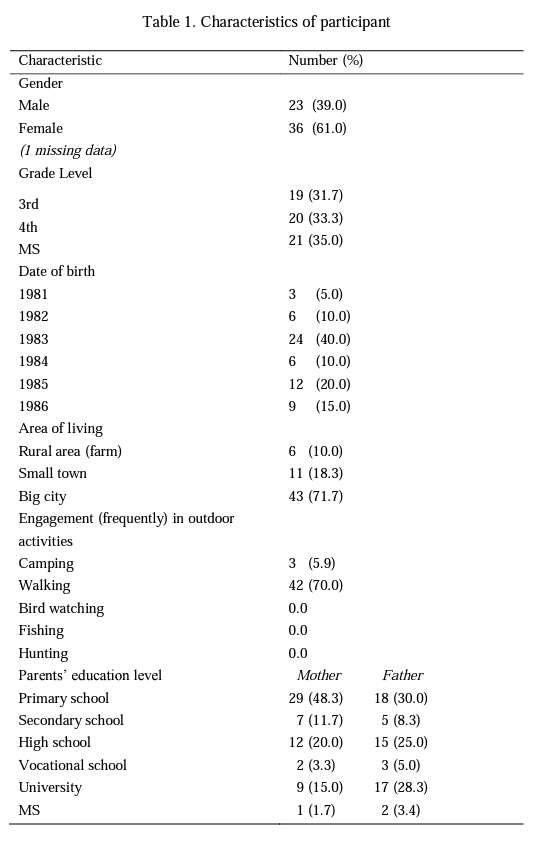
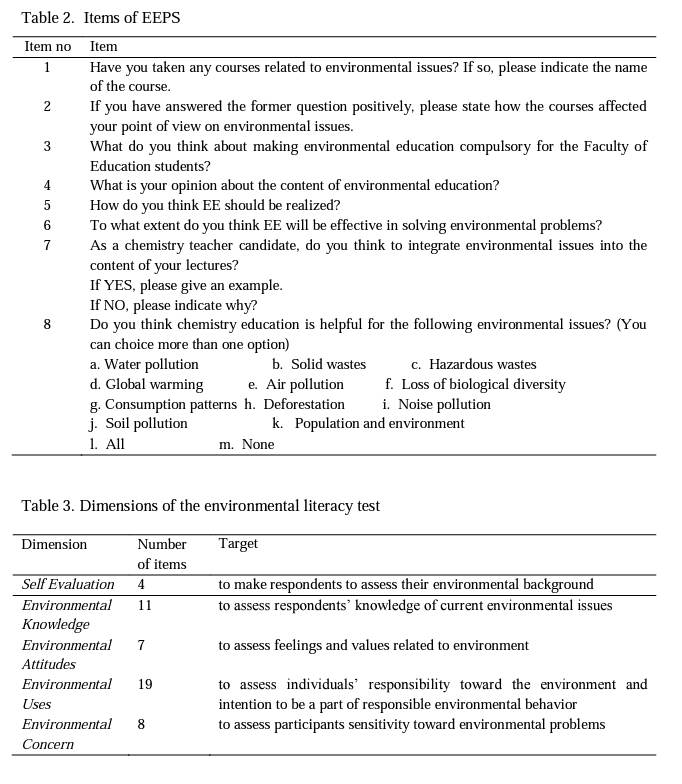
On the other hand, quantitative data analysis methods were followed for participants' responses on ELT. In order to identify the level of pre-service chemistry teachers' environmental literacy, frequencies was determined through descriptive statistics.
Results
Environmental Literacy Test (ELT)
Participants ’ self evaluation on environmental background
Participants' were made to evaluate their environmental background by means of answering four questions about their habits of environment related activities and their perceptions on the environmental problems. As presented in Table 4, 90 % of the chemistry education students state environment as the 2 or 3 of the most important problems and 70% of them state that they know a fair amount, whereas 15 % thinks that they know a lot and another 15 % thinks that they know only a little about the environmental issues and problems. Chemistry education students of this study evaluate their parents concern about environmental problems as, not very much (50%) and a fair amount (30 %) and they state that their parents are not active at all in promoting environmentally friendly behavior (58%).
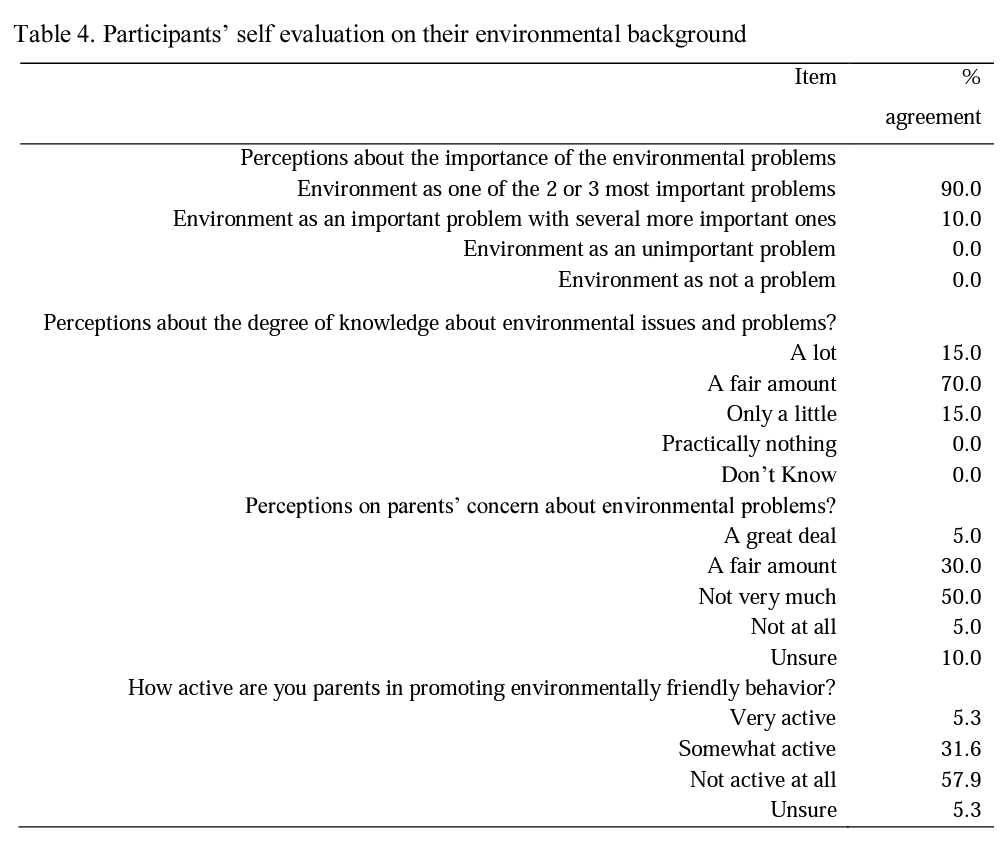
Environmental knowledge
The environmental knowledge of pre-service chemistry teachers was evaluated using individuals' ‘correct' responses to the knowledge items (Table 5). According to the results, the environmental knowledge item that great majority of the pre service chemistry teachers answered correctly concerned the definition of biodiversity (90%). The knowledge item answered incorrectly by all the participants concerned industrial discharges as one of the major sources for surface water pollution. Hundred percent of the participants answered this item as discharge of municipal solid wastes. Only 26.3 % of the participants, on the other hand, stated the motor vehicles as the major contributor of carbon monoxide; more than 70 % of respondents incorrectly identified factories and business as the major source of carbon monoxide. Percent correct responses for the other items were above 50 %. But, the results for the answers for the knowledge items may be evaluated as disappointment as far as their subject is considered; as only 50 % of the chemistry education pre service teachers correctly answered the item about nuclear wastes and only 55 % of them correctly answered the item about household hazardous wastes.
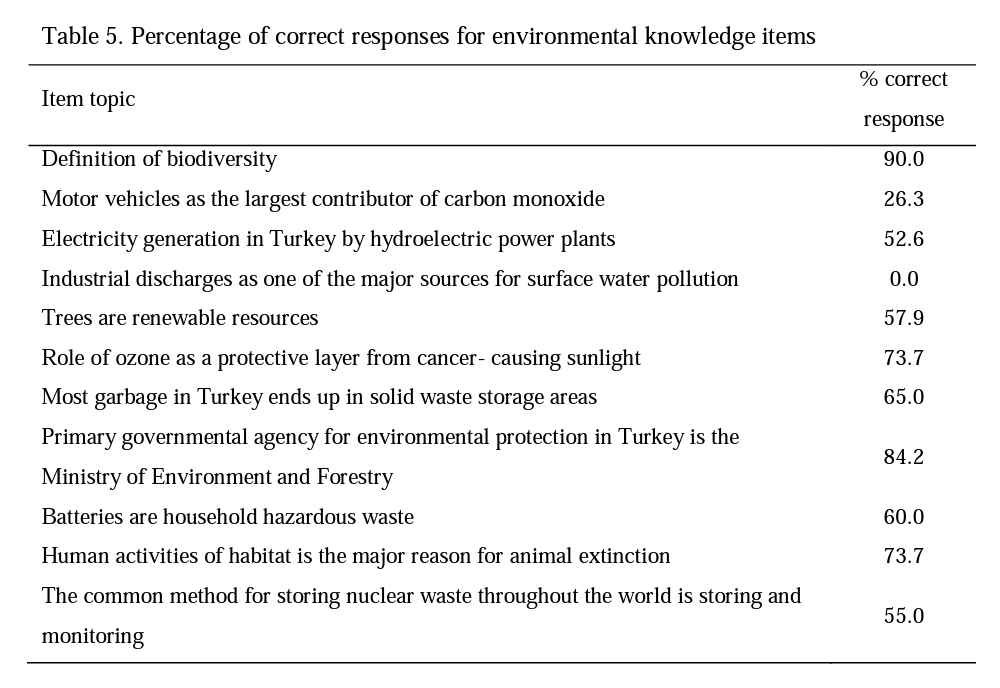
In addition to frequency analysis for participants' responses on each environmental knowledge items, total scores for this dimension were also calculated. To be able to gain a passing score, a participant should answer minimum 8 questions correctly. A total score less than 8 is unacceptable (NEETF/Roper, 2005). With respect to these criteria, only 15 (25%) pre-service teachers could obtain a passing score on environmental knowledge whereas 45 (75%) students received an unacceptable score (Table 6).
Environmental attitudes
Environmental attitude items used in the survey were adapted from a measuring tool used by NEEFT/Roper (2005) for the study titled "Environmental Literacy in America". As Table 7 displays, large percentages of the respondents agree with the statements like, "If things continue on their present course, we will soon experience a major ecological catastrophe." (79%), "When humans interfere with nature it often produces disastrous consequences." (76%), and "We are approaching the limit of the number of people the earth can support" (57%). Likewise, a large percentage of respondents undecided about the statements like, "The so-called ‘ecological crisis' facing humankind has been greatly exaggerated" (50%), "The balance of nature is strong enough to cope with the impacts of modern industrial nations" (37%), "Despite our special abilities humans are still subjects to the laws of nature" (30%). This illustrates that on average this group of Turkish chemistry pre-service teachers may be classified as pessimistic about the future state of the environmental problems.
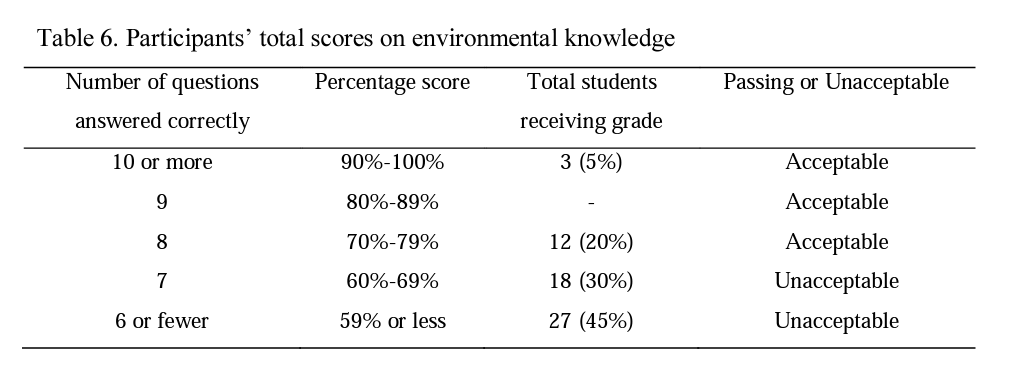

Environmental uses
The target of the environmental use items was to assess individuals' responsibility toward the environment and intention to be a part of responsible environmental behavior. The answers for the items of this part of the test reflect the responsibility of the chemistry pre service teachers of this study toward environment. As Table 8 displays, more than half of them show their awareness on individual responsibility in dealing with environmental problems by agreeing with the items like, "It is important that everyone be aware of environmental problems" (90%), "I feel personally responsible for helping to solve environmental problems" (95%), and "People should be held responsible for any damages they cause to the environment" (83%). However, they also stated that governmental responsibilities also are important in dealing with solutions for the environmental problems, by agreeing with the items like, "Laws regarding water quality should be stricter'’ (93%), "Government should pass laws to make recycling mandatory” (87%), "Government should regulate the use of private land to protect wildlife habitat” (75%) and disagreeing with the statement that, "Air pollution laws are already strict enough” (77%). Moreover, they believe in the science and technology (80%), change in the lifestyles (92%) and collective action (93%), cultural changes (65%) and people's values (75%) as the other factors to be dealt with, in solving environmental problems.
Table 8. Percentage of respondent agreement with environmental use items
Item | Agree | Undecided | Disagree |
Special areas should be set aside for endangered species. | 90.1 | 6.6 | 3.3 |
Laws regarding water quality should be stricter. | 93.4 | 3.3 | 3.3 |
Wild animals that provide meat for people are the most important species | 15.8 | 20.1 | 64.2 |
to protect. | |||
Poisonous snakes and insects that pose a threat to people should be killed. | 12.4 | 3.3 | 84.3 |
Landowners should be allowed to drain wetlands for agricultural or industrial uses. | 24.8 | 21.2 | 54.0 |
It is important that everyone be aware of environmental problems. | 90.1 | 6.6 | 3.3 |
Individuals should be allowed to use private land as they see fit. | 1.7 | 5.0 | 93.3 |
I feel personally responsible for helping to solve environmental problems. | 95.0 | 5.0 | 0.0 |
Government should regulate the use of private land to protect wildlife habitat. | 75.0 | 6.7 | 18.3 |
People should be held responsible for any damages they cause to the environment. | 83.3 | 5.0 | 11.7 |
All plants and animals play an important role in the environment. | 90.0 | 5.0 | 5.0 |
Technological changes often do as much harm to the environment as they do well for the environment. | 90.0 | 0.0 | 10.0 |
Government should pass laws to make recycling mandatory. | 86.7 | 8.3 | 5.0 |
Air pollution laws are already strict enough. | 1.7 | 21.7 | 76.6 |
Science and technology will be very important in solving our | 80.0 | 10.0 | 10.0 |
environmental problems. | |||
Cultural changes will be very important in solving environmental problems. | 65.0 | 30.0 | 5.0 |
Changes in people’s values will help solve environmental problems. | 75.0 | 20.0 | 5.0 |
Collective action (i.e. movements) is central to solving environmental problems. | 93.3 | 1.7 | 5.0 |
Lifestyle changes (i.e.. consumption) will help solve environmental problems. | 91.6 | 5.0 | 3.4 |
Environmental concern
The target for this section of the questionnaire was to find out the degree of concern of the students about the sources of environmental problems. The answers given by the students are presented in the Figure 1 below.
As was displayed in the figure, chemistry pre service teachers are very concerned about poor drinking water quality, ozone depletion, global warming and water pollution equally as 90 %. Therefore, it can be inferred that the degree of concern related to environmental problems is high for these students.
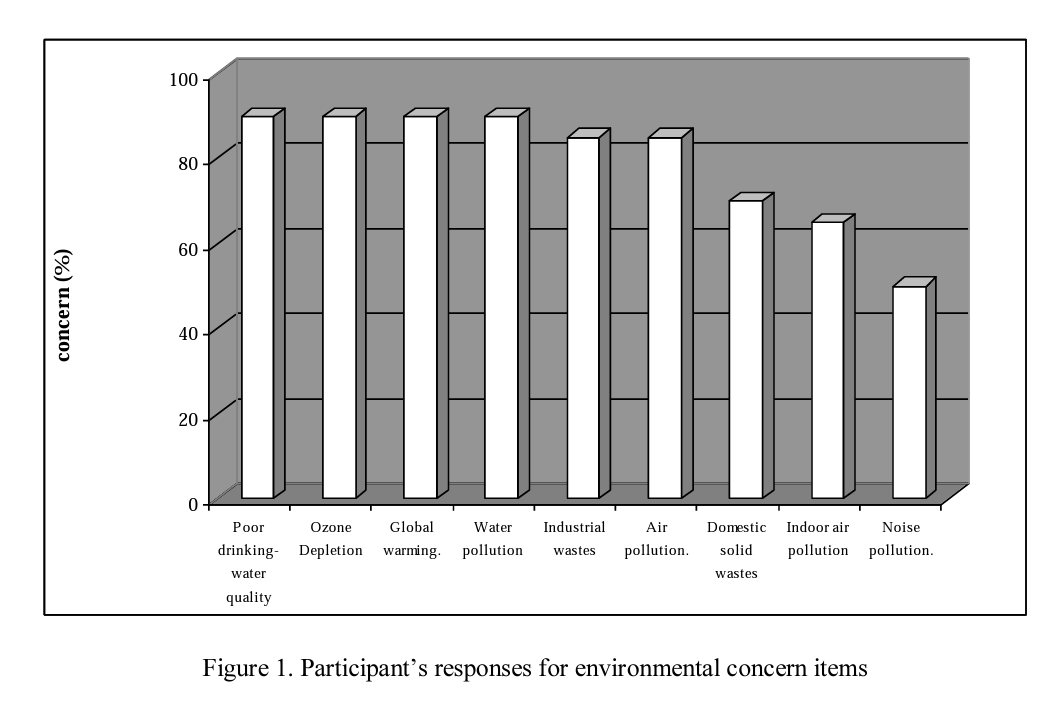
EE Perception Survey (EEPS)
Participants ’ enrollment in an environment-related course
A total of 11 pre-service chemistry teachers, out of 60, mentioned that they had taken an environment-related course. ‘Environmental Education” (ELE 473), “Education and Awareness for Sustainability” (ELE 474), “Environmental Chemistry” (CHEM 453) are the courses they enrolled and have been offered as elective courses by Faculty of Education and Department of Chemistry respectively. The one titled with “Environmental Education ” has been developed with
a general view that, to grow environmental awareness of a society requires the formation of an environmental-sensitive culture. The other course, “Education and Awareness for Sustainability”, aims to help students to understand how daily life and work can be adopted to improve the environment; to acquire awareness and sensitivity to the total environment; to acquire social values, strong feelings of concern for the environment and motivation for actively participating in its protection and improvement; to acquire a personal view of general and global environmental issue and to ensure that, students understand that they are part of the natural circle. The third course "Environmental Chemistry ” has been offered by Faculty of Arts and Sciences, Department of Chemistry. The course content is comprised of, description of the chemical problems related to environment, energy balance of the earth, ozone in the stratosphere, micro meteorology, acid deposition, greenhouse effect, photochemical smog and particles in the environment.
As presented in Table 9, one participant that obtained an acceptable environmental knowledge score for ELT had enrolled in the course with the title “Environmental Education ”. In addition, only one participant with an acceptable score from ELT enrolled in the course titled with “Education and Awareness for Sustainability”. On the other hand, nine of the students with an unacceptable environmental knowledge score exposed to one of these environment-related courses.
Table 9. Participants enrolled in environment related courses
ELT Score | Courses enrolled | ||||
| None | ELE 474 | ELE 473 | ELE 473 & ELE 474 | Environmental Chemistry |
Acceptable | 13 | 1 | 1 | 0 | 0 |
Unacceptable | 36 | 3 | 0 | 5 | 1 |
Total | 49 | 4 | 1 | 5 | 1 |
The Effect of enrollment in a course on perceptions of environment
The participants' responses on the contribution of enrollment in an environment-related course can be categorized as acquirement of awareness and sensitiveness toward environmental problems, development of an understanding on environmental deterioration and some skills that is necessary to make informed decisions on environmental issues, and finally enhancement of environmentally responsible behaviors. All of the pre-service teachers who had participated at least one environment-related course had a great emphasis on the changes in their feelings toward the enhancement of awareness and sensitiveness dealing with local or global environmental problems. However, partially limited number of participants mentioned deep understanding of environmental issues or taking environmentally desirable actions.
To exemplify, only one of the participants exposed to both “Environmental Education ” and “Education and Awareness for Sustainability” reported:
“I am no more just throwing away the garbage, but I began to use recycling bins consciously. ”
Furthermore, another participant enrolled in both of these two courses stated:
“These courses affected me in a favorable way. I saw that I had so many misconceptions or lack of necessary information on environmental issues. I am now more conscious on environmental problems. ”
Views on making environmental education a compulsory component in faculty of education
These pre-service teachers were asked to declare their views on environmental education a compulsory component in Faculty of Education. The results revealed that only three of the participants' responses were unfavorable toward making environmental education compulsory for teacher education programs. However, they did not propose any reason for this statement. Majority of the pre-service teachers who agreed on making EE compulsory believed that every teacher should be environmentally-literate in order to make EE a part of his/her own lessons. To exemplify, one participant stated:
"... Any teacher that does not have the desired awareness toward the environment and the literacy about it could not make environmental education a part of his/her lessons. ”
In addition, more than half of the participants (N=34) added that environment-related courses should be compulsory for not only pre-service teachers but also for university students from different academic fields. Thus, we can guarantee to grow environmental awareness and sensitiveness of a society.
Opinions about the scope of EE
The pre-service teachers also stated their opinions about the scope of EE in formal education. The participants' responses were categorized and could be presented as in Table 10. In the light of the findings, the participants generally agreed that environmental education in formal education system should cover how environmental deterioration or pollution has become a fatal issue globally, and the strategies that should be carried out to overcome environmental problems. On the other hand, some participants indicated that environmental education should emphasize some topics such as global warming, biodiversity, air and water pollution, energy usage, and health education.
Table 10. The scope of environmental education
Content | Frequency |
All issues dealing with environment | 6 |
Environmental pollution | 33 |
Resolution of environmental problems | 32 |
Global warming | 12 |
Environmental cycles | 8 |
Water and water pollution | 8 |
Biodiversity | 6 |
Air pollution | 3 |
Energy usage | 3 |
Health education | 2 |
Teaching strategies for environmental education
The pre-service teachers were asked to write up their views on how to teach pupils environmental issues in classroom environment. The participants stressed on four teaching strategies such as field trip, case study, learning cycle, and inquiry oriented instruction to attain the objectives in environmental education. The participants believed that student-centered classroom activities rather than teacher-centered ones should be used in an environment-related course. According to pre-service teachers, any teaching strategy that helps students to have direct experience in a naturalistic learning environment and provide an opportunity to make some observations would enhance their awareness toward the environment. On the other hand, they also suggested that some seminars provided by experts on environmental problems could be organized in order to overcome students' misconceptions on environmental issues and encourage them to take the necessary precautions to prevent environmental deterioration.
Views on contribution of EE in resolution of environmental problems
The pre-service teachers were asked to evaluate whether EE would make any contribution in resolution of environmental problems or conflicts. Except three participants, the pre-service chemistry teachers stated the direct contribution of environmental education in creating a better and healthier environment. The results reflected a common idea that environmental education could increase individuals' feelings of concern toward environmental problems, and enhance their awareness and sensitiveness toward environmental issues. However, the participants also added that the desired outcome would depend on the way that environmental education is provided. For instance, one of the participants reported:
Also, it depends on how environmental education is implemented... If the teacher uses lecturing as a teaching strategy and do not use student-centered classroom activities or alternative assessment techniques, we cannot expect to attain the objectives of environmental education. ”
In other words, environmental education must be compulsorily carried out in studentcentered classes that provide some opportunities for active participation in resolution of environmental problems.
Integration of EE issues into their own teaching practice
The pre-service chemistry teachers were also questioned whether they were willing to integrate EE issues into their own teaching practice. Except three participants who did not believe the contribution of environmental education in resolution of environmental problems, the pre-service teachers were planning to integrate these issues into their content of teaching. These participants provided similar examples for incorporation of environmental education into their own teaching practice. For instance, carbon monoxide emission and its effects on the environment, hazardous wastes and its damage on ecological balance, nuclear energy and nuclear power plants, air pollution, and water use were among the environmental issues that the participants intended to teach in their lectures.
Environmental issues in chemistry education
Finally, the pre-service chemistry teachers stated their views on whether chemistry teacher education program would make any contribution on teaching some environmental issues. The frequency of responses vs. some environmental issues that the chemistry teacher education program contributed on teaching has been given in Figure 2 below. The participants responded that chemistry teacher education program was helpful in teaching some of environmental topics such as air pollution, hazardous wastes, water pollution, global warming, and solids wastes. However, the participants did not believe that they could get sufficient information about population and environment, noise pollution, loss of biological diversity, and deforestation through this program.
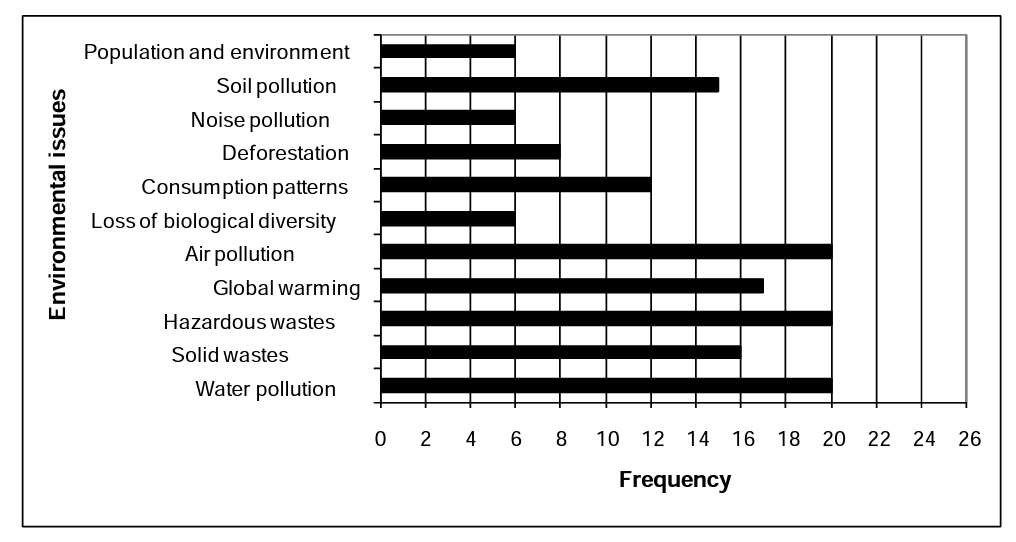
Discussion and Conclusion
The target of this study was to suggest a new vision for chemistry education teachers as environmental educators and to test this suggestion by means of investigating their tendencies for being environmental educators and measure their level of environmental literacy. As far as the research questions have been considered, most of the pre-service chemistry teachers were seemed to believe in the need for university students to be environmentally literate to grow the environmental awareness of the society. They strongly emphasized promotion of feelings of concern for the environment, development of awareness and sensitivity to the total environment, and gaining social values to protect the natural resources through teaching on environmental issues. These statements indicated that pre-service chemistry teachers had a clear sense of purpose for environmental education. Since some research findings (Chan & Yam, 1995; Alp, Ertepinar, Tekkaya, & Yilmaz, 2006) reported that higher emotional bonding toward the nature and increased awareness and sensitiveness to the environment would result in ultimate goal of EE, which is environmentally friendly behaviour. On the other hand, the pre-service chemistry teachers neglected the need to improve individuals' understanding of basic environmental issues. At this point it should be noted that limited environmental knowledge might be costly in terms of making uninformed decisions on preservation of the nature.
The findings of the present study also showed that the participants stated the reason for making EE compulsory in teacher education programs as to be capable of integrating environmental issues into their lessons. Although the percentage of them enrolling in an environment related course is low (Table 9), and although most of them have unacceptable degree of environmental knowledge, the pre-service chemistry teachers were planning to integrate environmental issues into their content of teaching. Besides, although they are pessimistic about the results of human activities on the resources, chemistry education preservice teachers feel responsible toward the environment and they intended to be a part of responsible environmental behavior (Table 8). Therefore, it can be stated in line with the results that, chemistry education students are potential candidates as environmental educators and their programs may be strengthened in this respect. And as important as them getting an environmentally literate teachers, as was also mentioned by chemistry education pre service teachers, it is also important for university students to get environmentally literate. Although there are several similar studies in the literature related to candidate teachers' and university students' environmental literacy, none of them targeted to test their perceptions as becoming environmental educators. Hsu and Roth (1999), for example, found that Taiwanese teachers had positive environmental attitudes, high levels of environmental sensitivity and responsibility, and moderate levels of internal locus of control. Robinson and Crowther (2001) compared the environmental literacy of biology majors, pre-service biology teachers, chemistry majors, and pre-service science teachers. Their results showed pre-service science teachers to be significantly more environmentally literate than chemistry majors but not biology majors and that pre-service biology teachers and biology majors did not significantly different in environmental literacy. Goldman et al. (2006) worked on the environmental literacy of teacher training in Israel and investigated the relationship between future teachers' environmental behavior and background in three major teacher-training colleges. Their study showed that future teachers had a low level of environmental literacy and this was reflected in their environmental behavior. Recently, Michail et al. (2007) studied with primary school teachers in Greece and concluded that, the teachers had several environmental knowledge gaps and misconceptions.
The present study highlights some critical issues for teacher educators and researchers in the field of environmental education. Based on our findings, the pre-service chemistry teachers enrolled in environment-related courses were strongly encouraged to infuse environmental issues into their teaching practice. The participants were willing to tackle environmental problems and motivated to play an active role in formation of an environmental-sensitive culture. Furthermore, these pre-service teachers were generally aware of the instructional strategies to handle environmental education in their classrooms. However, most of them judged themselves to be not equipped with the necessary subject matter knowledge necessary to develop students' understanding of environment-related concepts. These conclusions implied that some courses should be provided in teacher education programs in order to increase pre-service teachers' subject matter knowledge on environmental issues and problems as well as the current environment-related courses.
References
- Alp, E., Ertepinar, H., Tekkaya, C., & Yilmaz, A. (2006). A statistical analysis of children's environmental knowledge and attitudes in Turkey. International Research in Geographical and Environmental Education, 15(3), 210-223.
- Ballantyne, R., (1995). Environmental teacher education: Constraints, approaches and course design. International Journal of Environmental Education and Information, 14(2), 115-128.
- Boyes, E., Chambers, M., & Stanisstreet, M. (1995) Trainee primary teachers' ideas about the ozone layer. Environmental Education Research, 1, 133-145.
- Chan, R. Y., & Yam, E. (1995). Green movement in a newly industrializing area: A survey on the attitudes and behaviour of the Hong Kong citizens. Journal of Community & Applied Social Psychology, 5, 273-284.
- Cutter-Mackenzie, A. (2003). Eco-Literacy: The "Missing Paradigm" in Environmental Education. Unpublished doctoral dissertation, Central Queensland University, Brisbane.
- Fien, J., & Tilbury. D. (1996). Learning for a sustainable environment: An agenda for teacher education in Asia and the Pacific. Bangkok: UNESCO.
- Goldman, D., Yavetz, B., & Peer, S. (2006). Environmental literacy in teacher training in Israel: Environmental behavior of new students. Journal of Environmental Education, 3&(1), 3-22.
- Hsu, S. J., & Roth, R. E. (1999). Predicting Taiwanese secondary teachers' responsible environmental behavior through environmental literacy variables. Journal of Environmental Education, 30(4), 11-18.
- Jenkins, K. (1999-2000). Listening to secondary pre-service teachers: Implications for teacher education. Australian Journal of Environmental Education, 75(16), 45-56.
- Kaplowitz, M., & Levine, R. (2005). How environmental knowledge measures up at a Big Ten university. Environmental Education Research, 77(2), 143-160
- Mastrilli, T. (2005). Environmental education in Pennsylvania's elementary teacher education programs: A statewide report. Journal of Environmental Education, 36(3), 22-30.
- McKeown-Ice, R. (2000). Environmental education in the United States: A survey of preservice teacher education programs. The Journal of Environmental Education, 32(1), 4-12.
- Michail, S., Stamou, A. G., & Stamou, G., P. (2007). Greek primary school teachers' understanding of current environmental issues: An exploration of their environmental knowledge and images of nature. Science Education, 97(2), 244-259.
- Miles R., Cutter-Mackenzie, A. (2006). Environmental Education: Is it Really a Priority in Teacher Education?, Wooltorton, S. and Marinova, D. (Eds) Sharing wisdom for our future. Environmental education in action: Proceedings of the 2006 Conference of the Australian Association of Environmental Education 140, Chapter 16
- Miles, R., & Cutter-Mackenzie, A. (2006). Environmental Education: Is it really a Priority in Teacher Education? In S. Wooltorton, and D. Marinova (Eds.), Sharing wisdom for our future. Environmental education in action. Proceedings of the National Conference of the Australian Association for Environmental Education. Sydney: Australian Association for Environmental Education (1-6).
- Ministry of National Education of Turkey [MNE] (2005). llkögretim fen ve teknoloji dersi (6-8 similar) ögretim programi (Elementary school science and technology curriculum (grades 6- 8)). Ankara, Turkey.
- Morrone, M., Mancl, K., & Carr, K. (2001). Development of a metric to test group differences in ecological knowledge as one component of environmental literacy. The Journal of Environmental Education, 32(4), 33-42.
- NEETF/Roper (2005). The National Environmental Education & Training Emulation, Environmental Literacy in America. What Ten Years of NEETF/Roper Research and Related Studies Say About Environmental Literacy in the U.S.
- Powers, A. L. (2004). Teacher preparation for environmental education: Faculty perspectives on the infusion of environmental education into preservice methods courses. The Journal of Environmental Education, 35(3), 3-12.
- Robinson, M., & Crowther, D. (2001). Environmental science literacy in science education, biology and chemistry majors. The American Biology Teacher, 63, 19-14.
- Roth, С. E. (1992). Environmental literacy: Its roots, evolution, and directions in the 1990s. Columbus, OH: ERIC/CSMEE. Roth, Charles E. (1968). On the road to conservation. Massachusetts Audubon, June 1968, 38-41.
- Spork, H. (1992). Environmental education: A mismatch between theory and practice. Australian Journal of Environmental Education, 8, 147-166.
- Summers, M., Kruger, C., Childs, A., & Mant, J. (2000). Primary school teachers' understanding of environmental issues: an interview study. Environmental Education Research, 6(4), 293-312.
- Theodore, S. M. (2000). Elements of success in environmental education through practitioner eyes. Journal of Environmental Education, 37(3), 4-11.
- Tilbury, D. (1992). Environmental education within pre-service teacher education: The priority of priorities. International Journal of Environmental Education and Infomation, 11(4), 267-280.
- Tilbury, D. (1993). A grounded theory of curriculum development and change in environmental education at the teacher education level. Unpublished paper presented at the UNESCO Asia- Pacific Region Seminar on Environmental Education and Teacher Education, Griffith University.
- Tilbury, D. (1994). The International development of environmental education: A basis for a teacher education model? The International Journal of Environmental Education and Information, 13(1), 1-20.
- UNESCO UNEP (1977). Intergovernmental Conference on Environmental Education organized by Unesco in co-operation with UNEP Tbilisi (USSR) 74 - 26 October 1977
- UNESCO-UNEP. (1990). Environmentally educated teachers: The priority of priorities? Connect, .VI (I). 1-3.





